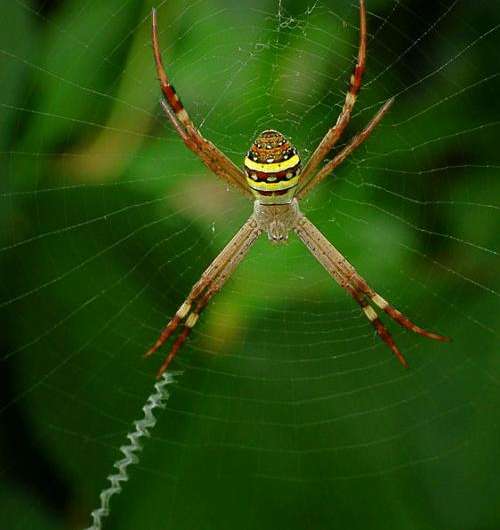March 31, 2014 weblog
Male St. Andrew's Cross spiders sniff web pheromones to determine suitability of female mates

(Phys.org) —A trio of researchers, two with the University of Hamburg in Germany and a third with Macquarie University in Australia has discovered that male St. Andrew's Cross spiders sniff the webs of female spiders to determine if they are suitable for mating attempts. In their paper published in the journal Behavioral Ecology, the team describes how they conducted experiments on several specimens of the species in their lab and discovered that male spiders could "smell" pheromones on the females web and used that information in deciding whether to attempt copulating with them or not.
St. Andrew's Cross spiders of both genders have dual sex organs—a left and a right. To copulate, the organs from both genders must match, i.e. right male to right female or left to left, or things won't work. Furthermore, when a male mates with a female, his organ (pedipalp) breaks off, forming a plug preventing other males from mating with that female's organ. The end result is that both genders can only mate twice.
But how do male spiders know if a female has already mated twice? Climbing onto her web for a closer look is dangerous, if the (much larger) female is hungry, she's likely to eat the intruder if both of her organs are plugged. To find out, the researchers placed a male on a wooden peg that two females had used to anchor their webs. The researchers found that the male was able to tell if the female was done mating by simply sniffing her web—he was able to pick up telltale pheromones, and thus avoid the females that provided no reproductive opportunity. Sadly, the sniff test was not able to also tell the male if he and the female had compatible organs remaining (left to left or right to right) for mating, thus, there was still some degree of risk in venturing onto the web.
Interestingly, the team also found that the males also would not mate with the same female twice, regardless if all other females in the vicinity were incompatible or already doubly mated. Such a strong predisposition suggests the urge to spread genes was stronger even than the urge to procreate.
More information: Can males detect the strength of sperm competition and presence of genital plugs during mate choice? Behavioral Ecology (2014) DOI: 10.1093/beheco/aru045
Abstract
Female reproductive status can have strong selective effects on male mating strategies due to the threat of sperm competition, which may explain why males prefer virgin over mated females. However, in mating systems with female multiple mating rates and mating plugs, males should not only respond to the risk but also to the level of sperm competition and should be sensitive to the interference from mating plugs. In the orb-web spider Argiope keyserlingi, females possess paired sperm-storage organs facilitating separate sperm storage from different males. Males are limited to 2 copulations due to mutilation of their paired genitals (pedipalps). By conducting binary choice experiments, we tested whether males of different mating status can distinguish between females that mated with 1 or 2 males and whether single-mated males discriminate between single-mated females with matched or unmatched virgin genital openings. Furthermore, we investigated whether males adapt their mating strategies to the intensity of sperm competition by providing males with varying qualities of females in their immediate vicinity. Our results demonstrated that males are sensitive to the level of sperm competition and preferred single-mated females over double-mated females. However, they failed to identify single-mated females whose virgin genital opening matched their unused pedipalp, which is required due to their fixed ipsilateral insemination. Surprisingly, males never mated twice with the same female independently of the quality of surrounding females. This suggests that the benefits from searching and mating with a different female are greater than the benefits of monopolizing the female by mating twice with her.
Journal information: Behavioral Ecology
© 2014 Phys.org



















